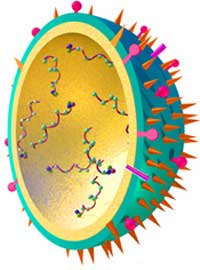H5N1 virus in Vietnam has reduced its virulence
 Research by the National Institute of Hygiene and Epidemiology shows that, compared to when it first appeared in Vietnam, H5N1 has had a slight change in genetics and pathogenicity. Over the past year, the gene that regulates its virulence has decreased from 99.1% to 98.2%.
Research by the National Institute of Hygiene and Epidemiology shows that, compared to when it first appeared in Vietnam, H5N1 has had a slight change in genetics and pathogenicity. Over the past year, the gene that regulates its virulence has decreased from 99.1% to 98.2%.
Dr. Nguyen Thuy Hoa, Head of Epidemiology Institute of National Hygiene and Epidemiology said, with the above change, the virus may have been more adaptable to the human body, leading to an increase in the number of infected people (especially is the number of infected people without symptoms), the clinical situation is lighter, the mortality rate is lower.
Surveys also show that influenza A type H5N1 occurs at all ages with the youngest being 4 months, the highest being 81 years old. However, the epidemic is concentrated in ages under 40, the highest in the age group of 10-19. The number of deaths in each age group corresponds to the number of deaths. In the North, mortality is significantly lower than in the South (38.1% compared to 83.3%).
Dr. Nguyen Tran Hien, Director of the National Institute of Hygiene and Epidemiology, said that the agency continues to take samples for testing. The national influenza surveillance program was carried out in Hanoi, Thai Binh, Nha Trang, Buon Me Thuat, Ho Chi Minh City from February, with taking samples of people with flu for testing. To date, thousands of samples have been transferred to the laboratories of the Institute and the regional Pasteur institutes, to detect H5N1 cases and study the transformation of the virus.
- Identify the gene that lethal in the H5N1 virus
- H7N9 influenza virus changes to high virulence
- H5N1 flu appears in poultry in Ninh Thuan
- New virus variants can delete mankind
- Warning for a new pandemic of bird flu in Vietnam
- There is a risk of pandemic influenza with the changing H5N1 strain
- Detection of the H5N1 virus strain by a test
- Prevention of toxic bird flu H5N6
- Restart studies of H5N1
- H5N1 virus is evolving
- Cats infected with H5N1 virus?
- IAEA uses nuclear technology against H5N1 virus
 March 2012: Launching H5N1 vaccine for poultry
March 2012: Launching H5N1 vaccine for poultry Experts comment on the mysterious gradual disappearance of the Delta variant in Japan
Experts comment on the mysterious gradual disappearance of the Delta variant in Japan Danger of the two Delta . branch variants
Danger of the two Delta . branch variants 2020 pandemic flu attack humans?
2020 pandemic flu attack humans? How many animals have ever existed on Earth?
How many animals have ever existed on Earth?  How did ancient wars know how many troops the opponent had?
How did ancient wars know how many troops the opponent had?  New research shows: Crows can 'read' numbers from 1 to 4
New research shows: Crows can 'read' numbers from 1 to 4  Slide Ruler - A simple invention that changed the history of science in the world
Slide Ruler - A simple invention that changed the history of science in the world  The sequence of numbers 142857 of the Egyptian pyramids is known as the strangest number in the world - Why?
The sequence of numbers 142857 of the Egyptian pyramids is known as the strangest number in the world - Why?  Only 110 people are needed to start a new civilization on Mars
Only 110 people are needed to start a new civilization on Mars 